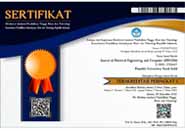Study of Potential Scalability Development of Palm Oil Mill Effluent-based Gas-fired Power Plant
Authors (s)
(1) * Ishananta Alfian Widanarko
 (Universitas Islam Indonesia)
(Universitas Islam Indonesia) Indonesia
(2) Wahyudi Budi Pramono (Universitas Islam Indonesia)
Indonesia
(*) Corresponding Author
AbstractIndonesia, as the world's largest producer of palm oil, generates a large amount of liquid waste that has the potential to be a renewable energy source. The main problem of liquid waste originated from palm oil industry, apart from its nature, is its potential long-term usability, especially when improvements in biogas-based power generating technologies are put into consideration. Based on these problems, the main purpose of this research is to compare the economical, technical, and environmental scalability between palm oil mill effluent (POME)-based biogas power generation and older, existing diesel-based power generation and analyzing their scalability potential in long term, in aim to increase the utilization of renewable energy portion in Indonesia. This research is conducted by observing an actual palm oil mill facility and its power generation system. Data are analyzed by qualitative and quantitative method by means of computer simulation before being compared with diesel-based power generation system. Based on simulations and comparative analysis, POME-based biogas can be utilized as a fuel source for power generation using gas-fired power generating technology, due to its methane content. With these characteristics, it is possible to analyze the scalability potential of POME-based biogas power plants in the diversification of new and renewable energy sources. Studies on potential development show that biogas power plants are more efficient and have a linear correlation with the volume of liquid waste, and can be adapted in lieu of power generating-related technology advancements. As a result, energy derived from POME can support energy independence and contribute to the growth of clean energy. |
Keywords
Full Text: PDF
Refbacks
- There are currently no refbacks.
Copyright (c) 2025 Ishananta Alfian Widanarko









